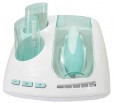Autism spectrum disorder is understood to have a number of risk components and paths of growth, so that neurologists call it a “heterogeneous” disorder. For some youngsters there's a genetic component to autism: over one thousand candidate genes have been related to autism, autism is known to run in some households, and twins and siblings usually tend to each have autism10-12. Multiple environmental danger elements have also been related to autism, together with parental age, maternal well being during pregnancy, heavy metal exposure in early childhood, and plenty of others13,14. Although the theory that “vaccines cause autism” has been conclusively disproved15, we do know that youngsters with autism usually tend to have heightened immune system activity16,17 and neuro-inflammation in the brain18,19. There's a saying in this community that, “If you will have met one person with autism, then you will have met one particular person with autism” because no two case are alike20.











